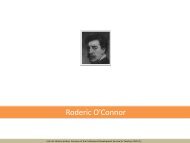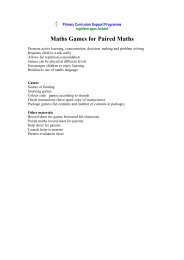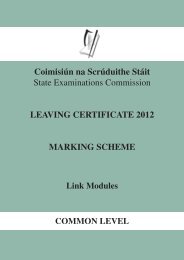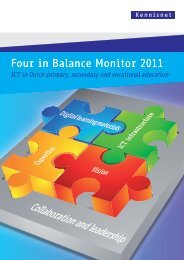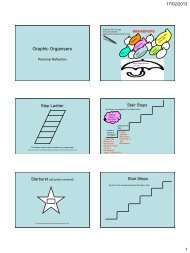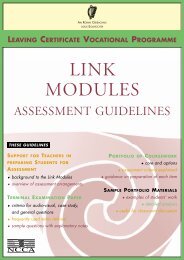GUIDELINES FOR TEACHERS - Curriculum Online
GUIDELINES FOR TEACHERS - Curriculum Online
GUIDELINES FOR TEACHERS - Curriculum Online
You also want an ePaper? Increase the reach of your titles
YUMPU automatically turns print PDFs into web optimized ePapers that Google loves.
PHYSICS<br />
Some years later Carl C. Anderson observed exactly such<br />
a particle when he identified the tracks of an “electronpositron”<br />
pair created out of energy by cosmic radiation.<br />
We now know that not only the electron but every particle<br />
of matter has a twin composed of antimatter. Our part of<br />
the universe is composed of what we call “matter”,<br />
but examples of antimatter on our planet are present on a<br />
very small scale, as discussed below.<br />
Some radioactive elements decay by beta emission of a<br />
positron. For example:<br />
15<br />
8 O → 15 7 N + e+ + ν<br />
In medical imaging (positron emission tomography, PET)<br />
such elements are used as tracers to monitor, for example,<br />
the dissipation of a drug in the human body. When the<br />
positron is emitted it very quickly meets an electron, to<br />
produce the annihilation reaction<br />
e + + e – → γ + γ<br />
The two gamma rays go off in opposite directions and<br />
can be detected to give an accurate fix on the position<br />
of the tracer.<br />
In high-energy accelerators, pairs of protons and antiprotons<br />
can be produced in reactions such as<br />
p + p → p + p + p + p — + π + + π –<br />
The antiproton (p — ) has negative charge and a mass exactly<br />
equal to that of the proton.<br />
It is quite conceivable that some of the distant galaxies are<br />
composed of antimatter. There is no reason why even living<br />
organisms should not exist in these galaxies. It may also<br />
be conjectured that at the 'big bang' of creation, matter<br />
and antimatter were created in equal amounts and then<br />
dispersed throughout the universe. If matter and antimatter<br />
were to meet, mutual annihilation would occur resulting in<br />
the release of great amounts of energy.<br />
THE THREE-QUARK MODEL<br />
How to bring order to the Particle Zoo<br />
In 1964 Murray Gell-Mann and George Zweig introduced<br />
the idea that all the mesons and baryons in the Particle<br />
Zoo could be expressed in terms of three basic constituents,<br />
called quarks.<br />
TABLE 3. PROPERTIES OF QUARKS<br />
Quark Charge Anti-quark Charge<br />
up u<br />
2<br />
2<br />
+ u — –<br />
3<br />
3<br />
down d<br />
1<br />
−<br />
d — 1<br />
+<br />
3<br />
3<br />
strange s<br />
1<br />
−<br />
3<br />
s — + 1 3<br />
By combining the quarks in various ways all the mesons<br />
and baryons in the Particle Zoo can be constructed.<br />
The leptons are not composed of quarks and are<br />
fundamentally indivisible.<br />
TABLE 4. CONSTITUENTS OF SOME<br />
OF THE BARYONS AND MESONS<br />
ACCORDING TO THE QUARK MODEL<br />
Particle Constituents<br />
pi-meson π + ud —<br />
π − ud<br />
K-meson Κ + us —<br />
proton p uud<br />
anti-proton p — —<br />
uudud<br />
neutron n udd<br />
lambda Λ 0 uds<br />
omega Ω − sss<br />
By adding the electric charges of the quarks it is possible<br />
to verify that the combinations in table 4 give the correct<br />
charge of the parent particles. The electric charge is just<br />
one property of the quarks in the model: there are many<br />
properties that all have to add up to give the right values.<br />
The model proved very successful and in fact predicted the<br />
existence of the last particle in table 2, the omega, which<br />
at the time had not been discovered. In 1969 Murray<br />
Gell-Mann was awarded the Nobel Prize for “his<br />
contributions and discoveries concerning the classification<br />
of elementary particles and their interactions”.<br />
29



